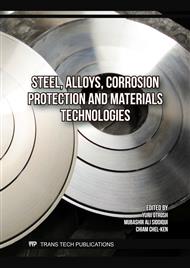p.75
p.87
p.99
p.109
p.133
p.145
p.155
p.163
p.179
Investigation of Mechanical Properties of Oxide Films on the Base Nb, Ta and Zr
Abstract:
The mechanical properties of anodic oxide films of Nb, Ta and Zr were studied by the nanoindentation method. Anomalously high elastic recovery after deformation was observed for oxides with thickness of 20 nm. An analogue of this behavior can be elastic membrane fixed on soft base that does not prevent the membrane from bending. Increase of the oxide thickness to 300 nm reduced the effect associated with the high elasticity of oxide and easy deformation of the soft metal substrate, and was accompanied by an increase in the plastic component of deformation, which is similar to the behavior of ceramic materials with low elastic and significant residual plastic deformation.
Info:
Periodical:
Pages:
155-161
Citation:
Online since:
November 2025
Authors:
Price:
Сopyright:
© 2025 Trans Tech Publications Ltd. All Rights Reserved
Share:
Citation:


